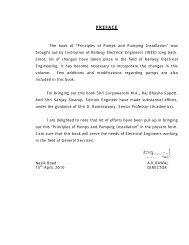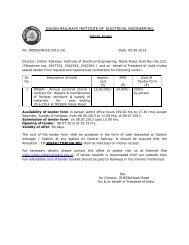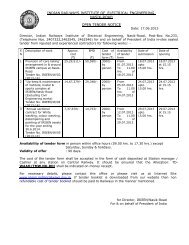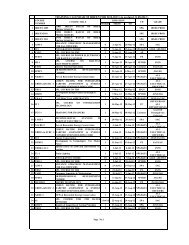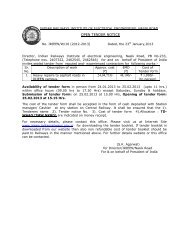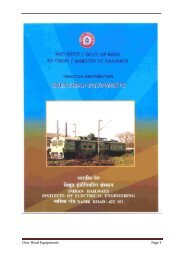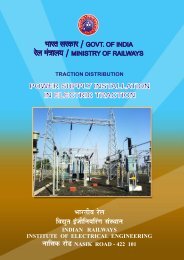Traction Rolling Stock - Indian Railways Institute of Electrical ...
Traction Rolling Stock - Indian Railways Institute of Electrical ...
Traction Rolling Stock - Indian Railways Institute of Electrical ...
Create successful ePaper yourself
Turn your PDF publications into a flip-book with our unique Google optimized e-Paper software.
10. AC EMU DESCRIPTION OF<br />
ELECTRICAL CIRCUITS<br />
10.1 POWER CIRCUIT<br />
10.1.1 Ro<strong>of</strong> equipments (Ref. Fig.10.1.1)<br />
The pantograph is connected to the ro<strong>of</strong> bushing <strong>of</strong> the 25 kV cable via the air-blast<br />
circuit breaker, the live side <strong>of</strong> which has a surge diverter connected between it and earth, At ro<strong>of</strong>mounted<br />
earthing -switch is provided, having two eathing blades in the closed position, these<br />
blades contact both sides <strong>of</strong> the air-blast circuit breaker isolator arm, thereby earthing both the<br />
pantograph and the primary winding <strong>of</strong> the transformer.<br />
10.1.2 Transformer<br />
The 25 kV cable from the ro<strong>of</strong> bushing passes through. The emergency driving cab and<br />
enters the transformer through another bushing where a connection is made to the primary<br />
winding is brought out by an insulated cable which is connected to the traction motor earth<br />
brushes coming on the four axles. The earth brushes are insulated from the motor frames. The<br />
transformer return is therefore kept independent <strong>of</strong> the earthing <strong>of</strong> the equipment cases and under<br />
frame.<br />
Primary overload protection is provided by a relay operated through a current<br />
transformer. The primary overload relay (OLP) is combined with the earth fault relay (EFR) (Ref.<br />
fig 10.4), to form a double-element relay having a common set <strong>of</strong> interlocks and reset coil. Tripping<br />
<strong>of</strong> either OLP or EFR causes the air-blast circuit breaker (ABB) to open. The two trip elements are<br />
provided with flags to indicate which relay has caused the trip. The flag indication remains after the<br />
relay has been reset electrically, the flag must be reset manually. The transformer secondary<br />
consists <strong>of</strong> two separate windings each <strong>of</strong> 350V. One half has four taps dividing it into five sections<br />
each 70V.<br />
In the first half <strong>of</strong> the notching sequence, only the tapped portion <strong>of</strong> the winding is used,<br />
while for the remaining notches the two sections are connected in series. The changeover is<br />
effected by means <strong>of</strong> contacts W1 and W2 on the winding- grouping switch and are only operated<br />
<strong>of</strong>f load.<br />
The tap changer contactors T1 to T9 carry out the switching <strong>of</strong> the transformer sections.<br />
Contactors T1 to T6 are connected to the transformer tapings and select the required voltage. Tap<br />
changing is carried out by means <strong>of</strong> reactor TL, in conjunction with the two contactors T7 and T8<br />
to give alternate notches with and without the reactor in circuit. A resistor is also provided in series<br />
with the reactor. But this is in circuit only during the actual tap changing operation, being<br />
immediately cut out <strong>of</strong> circuit when contactor T9 closes. The purpose <strong>of</strong> this reactor is to ease the<br />
duty on the opening contactor by reducing the circulating current.<br />
The selected output voltage is fed through the overload relay trip coils OL5 and OL6 to<br />
the main rectifier unit. The function <strong>of</strong> this relay is described more fully under the heading<br />
TRANSFORMER OVERLOAD PROTECTION.






